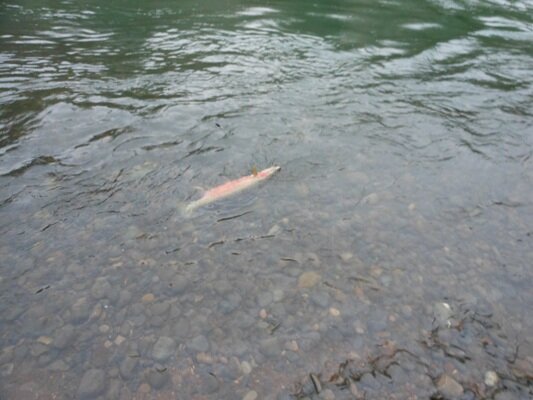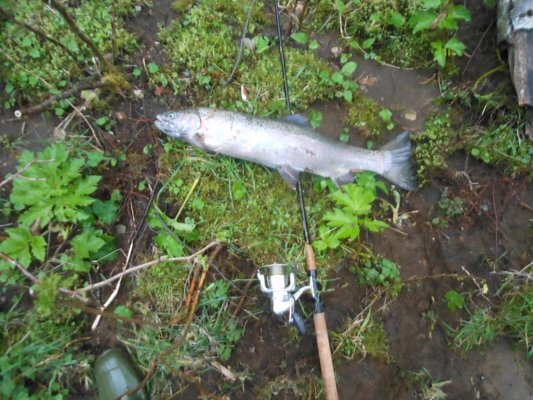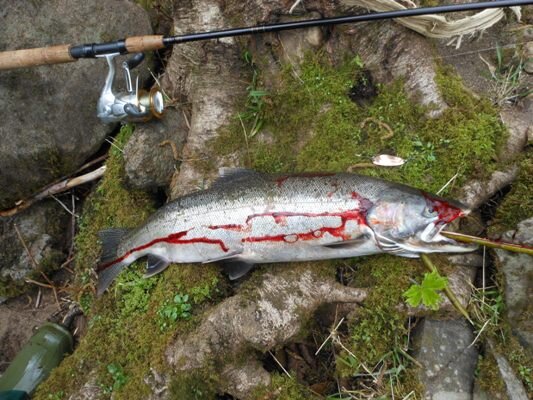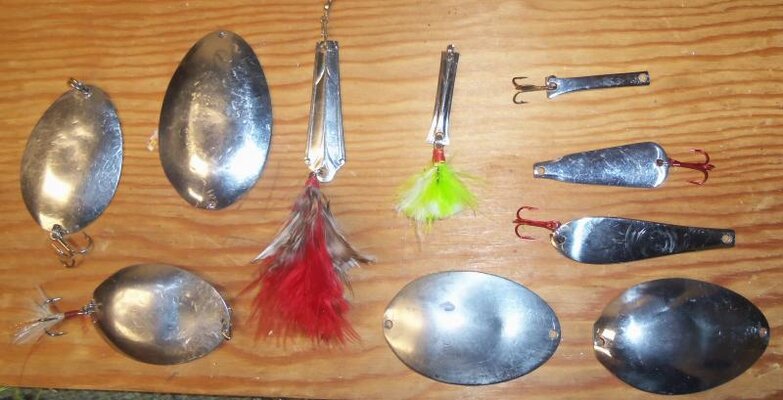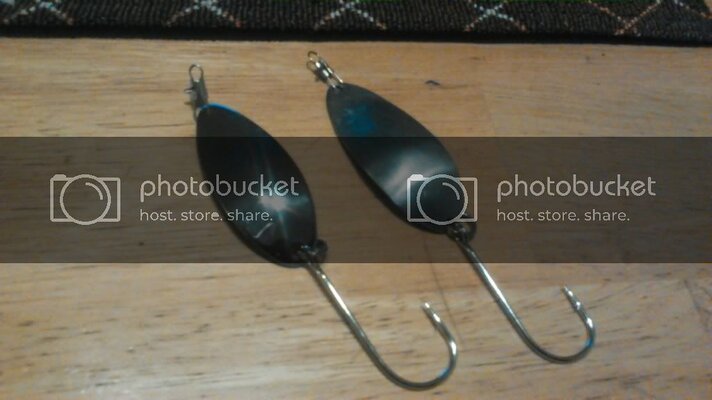C_Run
Well-known member
I know I have already mentioned how last year I got into using spoons for steelhead after studying Herzog's book and began to finally have some success. I also recalled how a friend some years back, before I started fishing, showed me his homemade spoons made from spoons he collected. So, with the wheels turning, I picked up three silver plated spoons at thrift stores this past year and set them aside for future spoon making. They were junk and cost about $1 each. During the big rains recently I decided to fabricate the spoons. I'll say you don't need to be Thomas Edison to do this. You need a drill, a hacksaw, and a file plus the spoons, some split rings, barrel swivels, and some big old Siwash hooks. That's it.
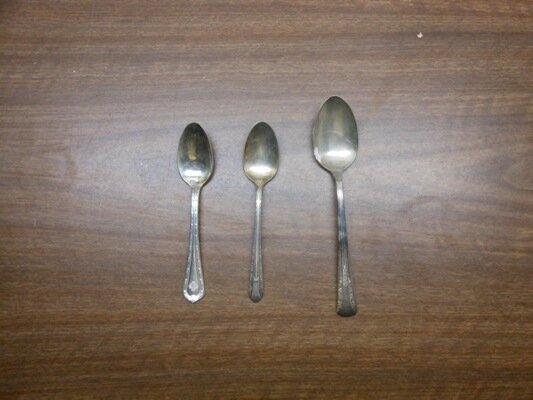
Cut off the handles and drill big enough holes for the split rings to move freely. Use the file to clean up burrs. Attach the rings, hook, and swivel. Make sure the hook faces the concave side of the spoon. Here is a picture of one of the small ones next to some common commercial spoons.
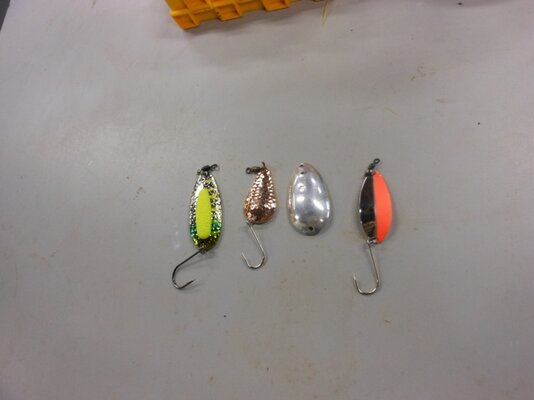
Here are the finished spoons. The big one is going to be a "salmon" spoon. I experimented with hammering one of them with a nail set. That did not go well as the spoon was very soft and it just made it look beat up. I also screwed up the first hole I drilled which is why the one has an extra hole out of place. Why "Searun"? I have a little set of number and letter dies and hammered the word "Searun" on the concave side of the one with the extra hole where it usually says "Steelie".
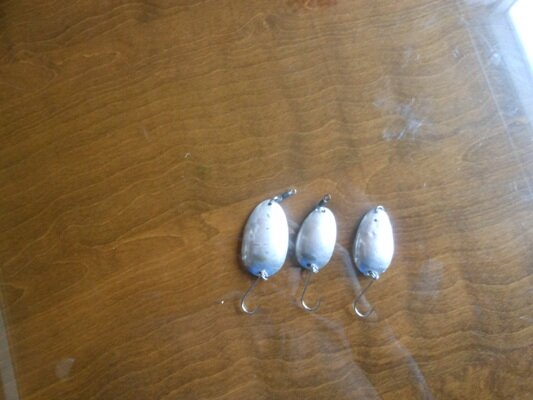
They look clunky and industrial like something out of the old Soviet Union. I intended to dress them up with paint and lure tape but, with the season running out I thought I better get out and do the field test as-is.
THE FIELD TEST 4/5/2012
I went to the heart of the coast range and only took the really beat up spoon with the extra hole in addition to the usual bobber rod and a bunch of Cleos and Steelies. Since I just had the one home made one along and since I usually lose a lot of gear on the bottom, my test was to be to only use it in holes where I had not lost gear before and had caught fish last year. Early on, I fished the first hole with the bobber and pink worm and a small Cleo for about 45 minutes with no bites. I then switched to the "Searun". I felt the Cleo wasn't getting down and the water was a bit off colored. The Searun was very heavy by comparison and sank fast and was very flashy. You feel the throb much stronger than with the commercial spoons because of the shape. On about the 5th cast it was fish-on briefly. A nice sized steelhead came out of the water and spit the hook. Needless to say I was encouraged. I never got another bite there so I moved on to hole number two. About the third cast produced this native.
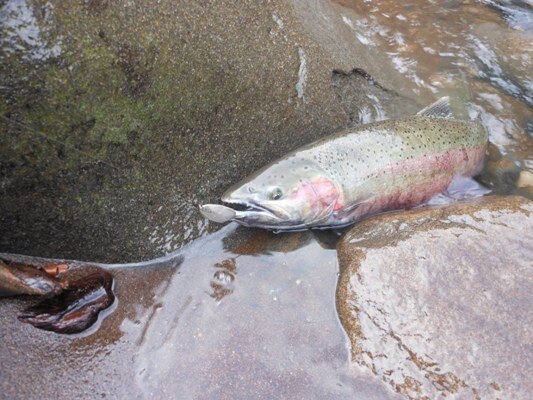
OK,OK...Busted...It was foul-hooked in the chin but I am counting it anyway. It twisted and the hook fell off (I got it back). I had not closed the gap on the Siwash enough and did not have pliers to fix it on the spot, only hemostats on me, so that was the end of the test. So live and learn.
CONCLUSION
You can make an effective spoon out of old silver spoons just don't use Grandma's good stuff. It is very satisfying to feel that bone-jarring hit on a spoon you've made yourself. My next project is to make kokanee jigs out of the handles. If that works, I'll let you all know.

Cut off the handles and drill big enough holes for the split rings to move freely. Use the file to clean up burrs. Attach the rings, hook, and swivel. Make sure the hook faces the concave side of the spoon. Here is a picture of one of the small ones next to some common commercial spoons.

Here are the finished spoons. The big one is going to be a "salmon" spoon. I experimented with hammering one of them with a nail set. That did not go well as the spoon was very soft and it just made it look beat up. I also screwed up the first hole I drilled which is why the one has an extra hole out of place. Why "Searun"? I have a little set of number and letter dies and hammered the word "Searun" on the concave side of the one with the extra hole where it usually says "Steelie".

They look clunky and industrial like something out of the old Soviet Union. I intended to dress them up with paint and lure tape but, with the season running out I thought I better get out and do the field test as-is.
THE FIELD TEST 4/5/2012
I went to the heart of the coast range and only took the really beat up spoon with the extra hole in addition to the usual bobber rod and a bunch of Cleos and Steelies. Since I just had the one home made one along and since I usually lose a lot of gear on the bottom, my test was to be to only use it in holes where I had not lost gear before and had caught fish last year. Early on, I fished the first hole with the bobber and pink worm and a small Cleo for about 45 minutes with no bites. I then switched to the "Searun". I felt the Cleo wasn't getting down and the water was a bit off colored. The Searun was very heavy by comparison and sank fast and was very flashy. You feel the throb much stronger than with the commercial spoons because of the shape. On about the 5th cast it was fish-on briefly. A nice sized steelhead came out of the water and spit the hook. Needless to say I was encouraged. I never got another bite there so I moved on to hole number two. About the third cast produced this native.

OK,OK...Busted...It was foul-hooked in the chin but I am counting it anyway. It twisted and the hook fell off (I got it back). I had not closed the gap on the Siwash enough and did not have pliers to fix it on the spot, only hemostats on me, so that was the end of the test. So live and learn.
CONCLUSION
You can make an effective spoon out of old silver spoons just don't use Grandma's good stuff. It is very satisfying to feel that bone-jarring hit on a spoon you've made yourself. My next project is to make kokanee jigs out of the handles. If that works, I'll let you all know.
Last edited:
